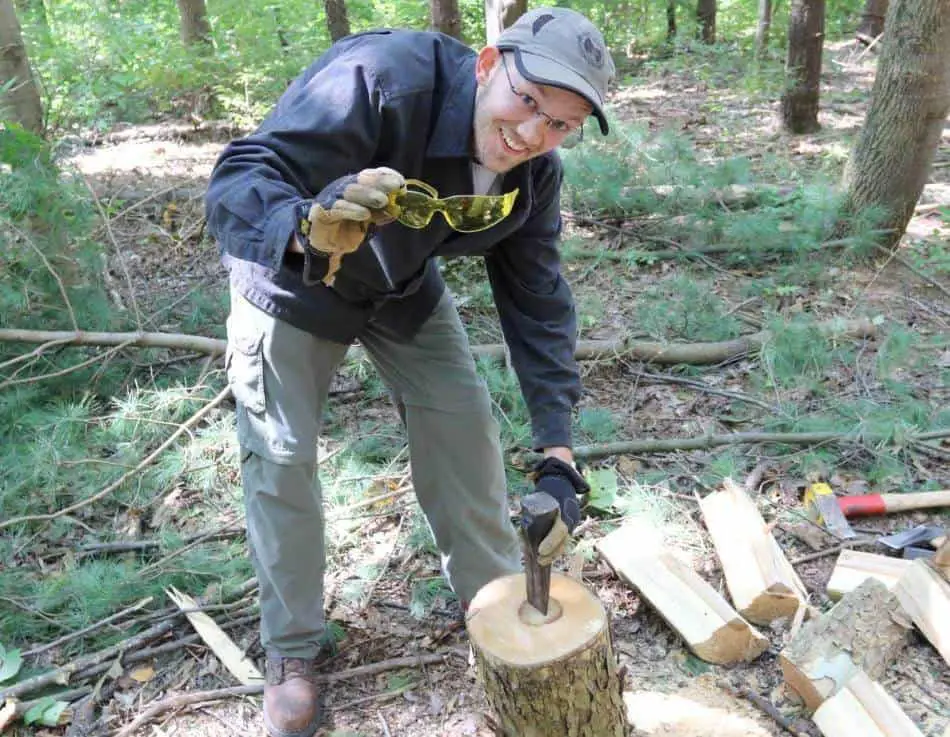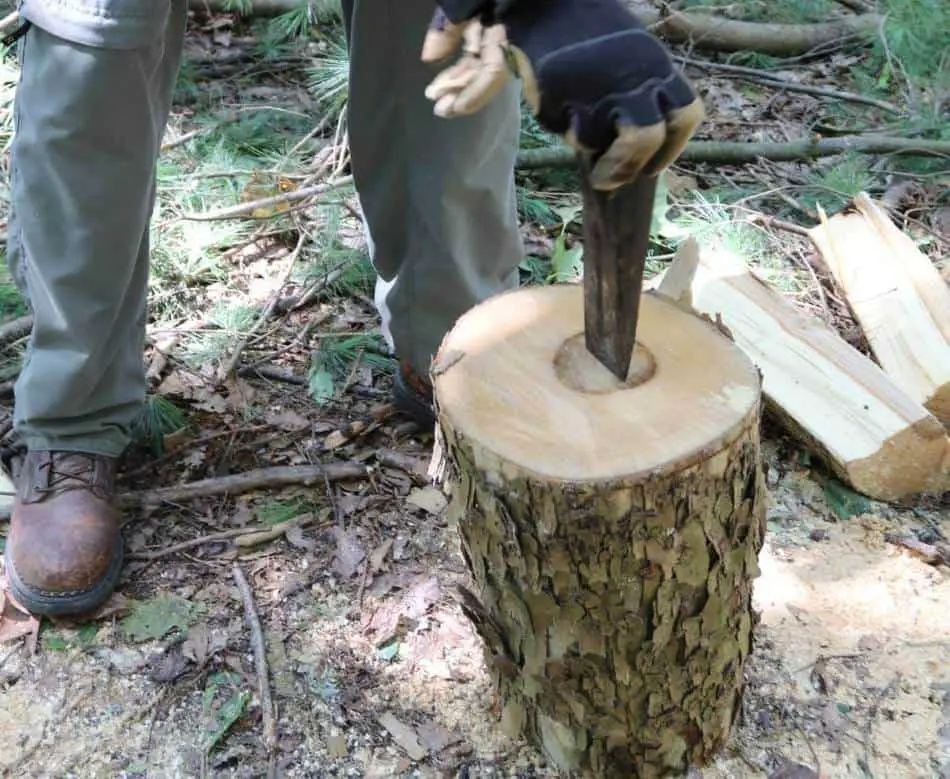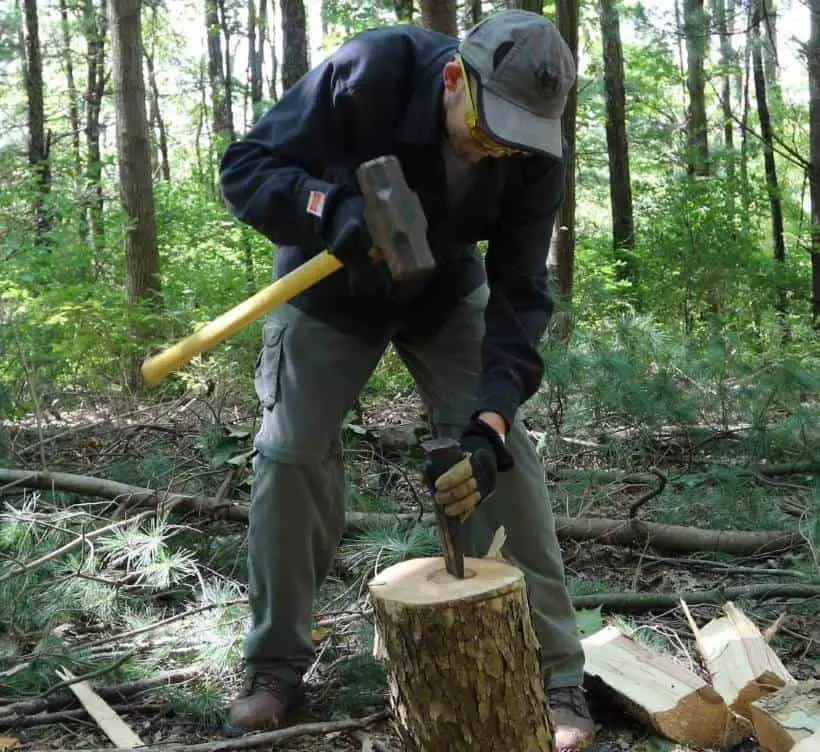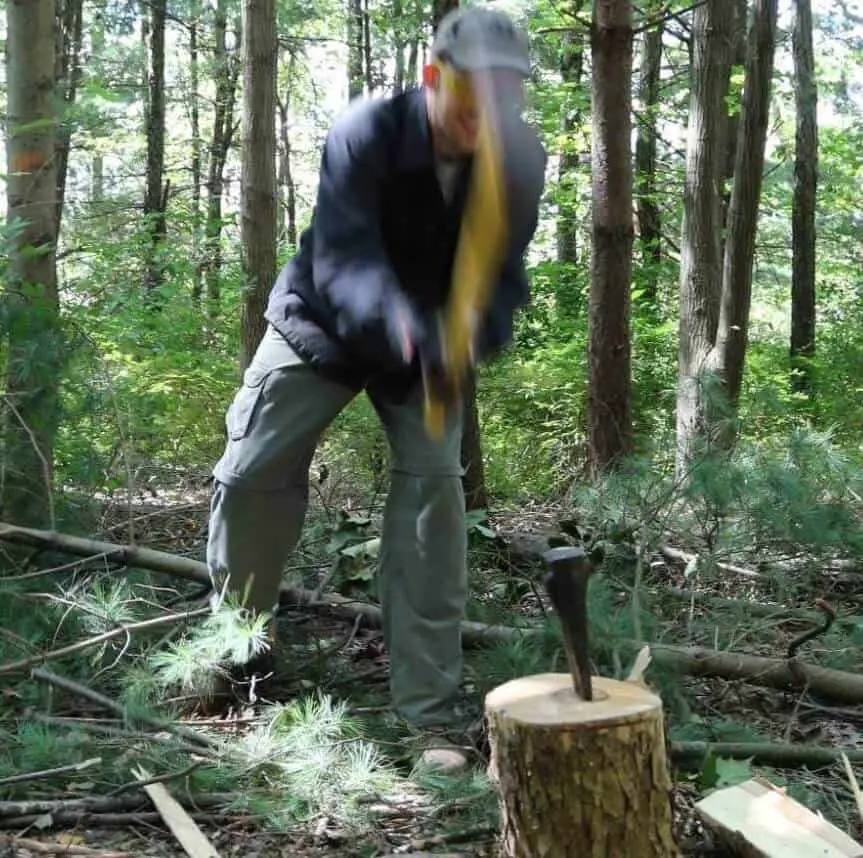
Splitting wood with a wedge can seem a bit mysterious because it’s so different than using a typical splitting axe.
The good news is, that with a few basic details, using a splitting wedge actually becomes a very simple process.
Follow the 7 steps below to learn how to split wood with a wedge, and you’ll be a master in no time! For a quick walk-through, check out my brief video tutorial:
1. Grab Your Tools

First thing’s first, you need to gather your supplies. In order to split wood with a wedge, you’re going to need 3 main things:
- A splitting wedge (preferably two)
- A sledgehammer
- A pair of safety glasses
It’s good to always have at least 2 splitting wedges with you because if one gets stuck or broken you’ll have a spare to finish the job. Or, if you’re dealing with a really big log, you can use both wedges together to split it.
It’s also important to note that a splitting wedge is a very different tool than a felling wedge, so make sure you get the right kind!
A splitting wedge looks like a splitting maul without a handle. Whereas felling wedges are much flatter. Felling wedges are also typically made of plastic (instead of steel) and are designed for cutting down trees.
In addition to a splitting wedge, you’ll need a sledgehammer. This is what you’ll use to drive the wedge through your logs. The blunt end of an axe will also work for this, but be careful, because that approach is a bit riskier.
Lastly, you’ll need a pair of safety glasses, and we’ll cover the reasons for that in more detail next.
2. Wear Safety Glasses

Safety glasses are particularly important when you’re using a splitting wedge. The process for splitting wood with a wedge involves pounding a steel wedge with a steel sledgehammer.
The metal-on-metal impact between the wedge and the hammer can sometimes throw small chips of steel into the air. This can be dangerous, and you especially want to avoid getting hit in the eyes with those chips.
Using a good quality wedge reduces the risk of chipping because the base of the wedge (where you hammer) will be made of “soft” metal. That basically means it will bend and flatten with impact, rather than chipping.
But, even if you a really high-quality wedge, you should still wear safety glasses as a precaution. Better safe than sorry!
3. Find Existing Cracks

Once you’ve got all your equipment together, grab the first log you plan to split. For this tutorial, I’m using a chunk of Sycamore.
At this point, you want to look at the grains of the log, and see if there are any existing cracks in the wood.
This will help you find natural points in the grain, where the wood will be easier for you to split. Align the edge of your wedge with any cracks you’ve identified, and this will be the location of your first split.
As a note on the size of the log, if you’re splitting something relatively small (like the one shown above), then you can typically split right in the middle of the log. However, for larger logs, it can help to start from the edges.
Alright, now the fun begins 🙂
4. Tap the Splitting Wedge In

Now you’re ready to begin the splitting process.
Start by holding your sledgehammer close to he head, and gently tapping the wedge into the wood to get it set.
Your goal is to get it into the wood far enough, that it is free-standing. Also try to drive it in straight, because if your wedge sits at an angle, it will be more difficult to drive it through with your hammer.
5. Choke Down on the Hammer

After you’ve set your splitting wedge in the log, and it’s free-standing, you can start doing some more serious swings.
Choke down lower on your sledgehammer handle, and aim for the middle of the base of the wedge.
You may want to take a test swing with your hands near the middle of the hammer’s handle to make sure the wedge is sturdy and won’t bounce out.
Then you can slide lower on the hammer’s handle, to get more leverage. From here on out, the process is kind of like hammering in a nail with a hammer.
6. Drive the Wedge Through

Last, but certainly not least, pound the wedge into the log with your hammer. This will probably take a few good hits, just keep it up until your log is split all the way through.
If your wedge gets stuck, you aren’t going to be able to pull it out. So the best approach for fixing the problem is to use a second splitting wedge to finish the job. This will then release your first wedge from the wood.
To use this approach, begin driving the second splitting wedge down the same crack as the first. Don’t go on top of the stuck wedge though, because then you’d chip the blade and damage both wedges.
Instead, place the second wedge just to the side of the stuck one, and begin hammering it in. This will create additional leverage against the wood, and 9 times out of 10, this will split the log and free both wedges.
7. Repeat for Additional Splits
Once you’ve finished your first split through the wood, you can repeat the steps above to split the wood into additional pieces.
It’s also worth mentioning that splitting wedges are best for really large or dense logs that you can’t split with a normal axe or maul. If you’d like to see splitting wedges compared to other options, then check out this article.
Related Questions
Splitting Wedge vs Maul
A splitting wedge works well for splitting large or dense logs, that will not split using a splitting maul. However, splitting with a wedge requires additional steps, and is typically slower and more difficult than using a maul. In appearance, a splitting wedge resembles a maul without a handle.
Splitting Wedge vs Felling Wedge
A splitting wedge is used for splitting logs, whereas a felling wedge is used to direct the fall when cutting down a tree. A splitting wedge is typically made of steel and resembles an axe without a handle. Felling wedges are much flatter and are typically made of plastic.
What Size Splitting Wedge Do I Need?
The standard size for a splitting wedge is 4-5 pounds. If you go much below 4 pounds, then you may as well just use a normal splitting axe. On the other hand, if you go above 5 pounds (like an 8-pound wedge), then it quickly becomes unwieldy and difficult to handle.
